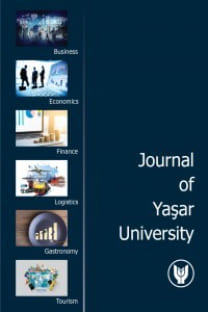DIFFERENT SIDES OF THE SAME COIN: MIXED VIEWS OF PUBLIC RELATIONS EDUCATORS AND PRACTITIONER ABOUT PUBLIC RELATIONS EDUCATION
Public relations education, public relations educators, practitioners
DIFFERENT SIDES OF THE SAME COIN: MIXED VIEWS OF PUBLIC RELATIONS EDUCATORS AND PRACTITIONER ABOUT PUBLIC RELATIONS EDUCATION
-,
___
- Anderson C. L. (1999) “Learning Partnerships: Involving Practitioners in Public Relations Education” Corporate Communications: An International Journal, 4 (1) 30–36.
- Berkowitz D.& Hristodoulakis I. (1999) “Practitioner Roles, Public Relations Education, and Professional Socialization: An Exploratory Study” Journal of Public Relations Research, 11(1), 91-103
- Coombs W.T. & Rybacki K. (1999) “Public Relations Education: Where is Pedagogy?”, Public Relations Review, 25(1), 55-63
- Cooper, B.J. (1979) “Attitude Toward Public Relations Education: A survey of Southern California Public Relations Practitioners” Unpublished Dissertation, California State University
- DiStasoa M.W& Stacks D.W. & Botanc C. H. (2009) “State of Public Relations Education in the United States: 2006 Report on a National Survey of Executives and Academics”, Public Relations Review, 35, 254-269.
- Eaton, R. E. (2000) “Writer’s notebook” Public Relations Quarterly, 45(2), 47–49.
- Ehling W.P. (1992) “Public Relations Education and Professionalism” in Excellent Public Relations edited by J.E. Grunig, New Jersey: Lawrence Erlbaum Associates, Inc.
- Ekachai D.& Komolsevin R. (1998) “Public Relations Education in Thailand” Public Relations Review, 24(2), 219-234.
- Elliot G.& Koper E. (2002) “Public Relations Education from an Editor’s Perspective” Journal of Communication Management, 7, (1) 21–33.
- Gibson D. (Winter 1992-1993) “ASK/PR: An Outcome Perspective on Public Reiations Education” Public Relations Quarterly, 45-48.
- Grunig, J. E. (1989) “Teaching Public Relations in the Future” Public Relations Review, 15(1), 12-24.
- Guiniven, J. E. (1998) “Public Relations Executives View the Curriculum: A Needs Assessment” Journalism and Mass Communication Educator, 52(4), 48–56.
- Haberstroh, J. (1995) “Public Relations Graduates don’t Measure up as Writers” Public Relations Quarterly, 39(4), 22–25.
- Hardin, M.C. Pompper D. (2004) “Writing in the Public Relations Curriculum: Practitioner Perceptions versus Pedagogy” Public Relations Review, 30, 357-364.
- Hatzios A.& Loriscy R.W. (2008) “Perceptions of Utility and Importance of International Public Relations Education among Educators and Practitioners” Journalism and Mass Communication Educator, 63(3), 241-258.
- Kazancı M. (2003) “Halkla İlişkiler Eğitimi Üzerine Bazı Düşünceler ve Yeni Eğitim Sistemi” Akdeniz Üniversitesi İletişim Fakültesi Dergisi, 131-151.
- Kruckeberg D. (1998) “The Future of PR Education: Some Recommendations”, Public Relations Review, 24(2), 235-258.
- L’Etang J. (2002) “Public Relations Education in Britain: A Review at the Outset of the Millennium and Thoughts for a Different Research Agenda” Journal of Communication Management, 7, 1 43–53.
- L’Etang, J.,&Pieczka, M. (2006). “Public Relations Education. In J. L’Etang&M. Pieczca (Eds.), Public relations: Critical debates and contemporary practice (pp. 433–442). Hillsdale, NJ: Erlbaum.
- Morton, C.C.(1993) “The Importance of Fund Raising Education to Students to Public Relations Practitioners and Students: A Curriculum Issue in Higher Education” Unpublished Dissertation, Texas Tech University
- Newsom, D.A.(July 1977) “PR Education: It’s More than Most Employers Think” Journalism Educator, 32(2), 36-39.
- Pease E.W.(1972) “Corporation Chiefs Help College Develop PR Course” Public Relations Journal, 28(9), 14-17.
- Rawel A. (2002) “How Far Do Professional Associations Influence the Direction of Public Relations Education?” Journal of Communication Management, 7(1) 71–78.
- Scott A.&Benfield S.(1971) “What Professionals Want” Forum, 8-11.
- Stacks D.& Botan C.& Turk J.V. (1999) “Perceptions of Public Relations Education” Public Relations Review, 25(1), 9-28.
- Sriramesh K.(2002) “The Dire Need for Multiculturalism in Public Relations Education: An Asian Perspective”, Journal of Communication Management, 7, (1) 54–70.
- Turk J.V. (1989) “Management Skills Need to be Taught in Public Relations” Public Relations Review, 15(1) 38-52
- Wakefield G.& Cottone L. (1986) “Education for the 80’s and Beyond” Public Relations Review, 12(2), 37-45.
- Wakefield G.& Cottone L. (1987) “Knowledge and Skills Required by Public Relations Employers” Public Relations Review, 13(3), 24-32.
- Wilcox D.L& Ault P.H& Agee W.K (1998) Public Relations: Strategies and Tactics, 5th Edition, USA: Addison-Wesley Educational Publishers Inc.,
- ISSN: 1305-970X
- Başlangıç: 2006
- Yayıncı: Yaşar Üniversitesi
Ayşe DEMİRHAN Serdar BOZKURT, Serdar BOZKURT
EMPLOYER’S OBLIGATION REGARDING CHILDCARE: IS IT A BACK STEP IN WOMEN’S EMPLOYMENT POLICY IN TURKEY?
TURKISH CORPORATE COMMUNICATION EXECUTIVE’S ATTITUDE AND OPINIONS ABOUT EMPLOYEE COMMUNICATION
Hakan KAHYAOĞLU Sezer BOZKUŞ, Sezer BOZKUŞ
MOBBING KAVRAMI VE ÖRNEKLERİ ÜZERİNE UYGULAMALI BİR ÇALIŞMA
M.Şule EREN Rahmi YÜCEL S.Selim EREN
